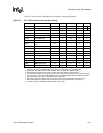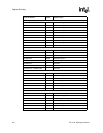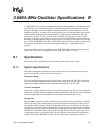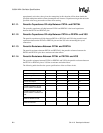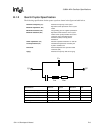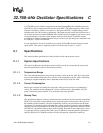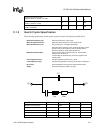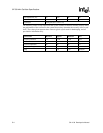
SA-1110 Developer’s Manual B-1
3.6864–MHz Oscillator Specifications B
A 3.6864-MHz crystal oscillator is integrated on the Intel
®
StrongARM
®
SA-1100 Microprocessor
(SA-1100) for use as a reference frequency for the PLLs that generate the internal clocks to the
processor. The phase noise of this reference frequency should be minimized because it could be
amplified by the PLLs, resulting in PLL output frequency jitter. For this application, the long-term
stability and the temperature effect on the frequency are not important because they affect the
frequency by less than 1%. The oscillator circuit is designed to work across a range of crystal
parameters so that the system designer can choose from several 3.6864-MHz crystals available on
the market. In normal operation, the pins of the crystal, Q1 and Q2, are connected to the SA-1100
pins, PXTAL and PEXTAL. Note that a 3.5795-MHz crystal can also be used, but in order to meet
the frequency specifications of several of the integrated I/O ports, a 3.6864-MHz crystal is
required.
In some applications, it may be desirable to provide the 3.6864-MHz reference from an external
signal source. This option is supported by the SA-1100. See Chapter 8, “Clocks”.
B.1 Specifications
This section includes specifications for the oscillator circuit and the quartz crystal.
B.1.1 System Specifications
This section includes the specifications of the oscillator circuit. It assumes that the crystal used
meets the specifications given in the following sections.
Temperature Range
This is the junction temperature range for the oscillator circuit on the SA-1100. The crystal itself
may be at the ambient temperature; the oscillator circuit integrated on the SA-1100 is most likely
operating at a higher temperature that is dependent on the activity of the SA-1100.
Current Consumption
Because this oscillator might run during the sleep mode of the processor, the power consumption is
critical. The specified current consumption is for the oscillator only. The power associated with the
oscillator output buffer is not included because this buffer is powered down in sleep.
Startup Time
This specification depends on the crystal characteristics and the layout of the printed circuit board
(PCB). The value given assumes that the crystal and board layout conform to the values given in
the remainder of this document. The critical parameters in the crystal specification are the shunt
capacitance (Co) and the motional resistance (Rm), which must be no greater than the maximums
specified. The critical parameters in the PCB layout are the parasitic capacitances between PXTAL
and PEXTAL, and between either of these nodes and VSS. Note that in some applications, such as
a system that includes a socketed SA-1100, it may be difficult to meet the parasitic capacitances
specified. While the 3.6864-MHz oscillator will start with parasitic capacitances, which are



